Life and Studies Coalesce for Montclair Senior
How one student’s hearing loss led her on a path to independent study, research and academic pursuits
Posted in: Homepage News, Research, University
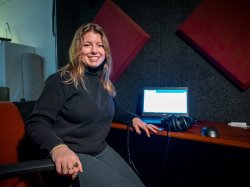
It was the beginning of one of her favorite Red Hot Chili Peppers songs that led to Montclair State University senior Evyn Stewart’s hearing test and unilateral hearing loss diagnosis at a young age.
Stewart, who was 8 or 9 at the time, says much of the diagnosis went over her head but she recalls what led up to it: She was listening to “Slow Cheetah” in the car when her father cranked up the volume.
“I didn’t know that the lead singer had said a little blurb in the beginning of the song, and I was like, ‘Oh, that’s so strange,’ ’’ she says.
A hearing test revealed hearing loss in her left ear. “After that hearing test, it made perfect sense why I would be missing that part of the song at a certain volume because I was missing the low end and the high end of a certain frequencies on the audiogram.’’
That song, diagnosis and decades of visits to an ear, nose and throat doctor and audiologist led Stewart to an independent study in Montclair’s Communication Sciences and Disorders department this semester – as an undergraduate in a graduate-level lab.
A Linguistics major in the College of Humanities and Social Sciences, Stewart is working in Montclair’s Communication Sciences and Disorders Clinical Biofeedback Lab, also known as MSU-CBL, studying adolescents with unilateral hearing loss, and will present her research findings at the New Jersey Speech, Language and Hearing Association’s Annual Convention in April.
The 21-year-old has tackled the study with the same grit and grace – and a good dose of humor – with which she handles her hearing loss. Stewart has seen her pediatric ENT since she was 2. She suffered from ear infections and had to have tubes put in her ears as a toddler through fourth grade. She did without them for a short period but an ear infection led to a perforated eardrum in her left ear.
“That was the first of four perforations, and so I currently have a tube in my ear. I get it replaced every four years or so,” she says, joking that she’s going to have to find a “big girl ENT” soon. The tube, she explains, “stabilizes my eardrum and equalizes the pressure. There’s a bunch of scarring in my ear and on my Eustachian tube, and that’s what led to my unilateral conductive hearing loss.”
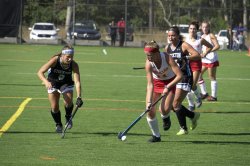
Stewart also has been playing field hockey since she could hold a stick and has been a member of Montclair’s field hockey team for four years. Her hearing loss, she says, has been her biggest challenge on the field.
“Definitely I feel the impact in sports. I have a hard time telling directional sound. If I have a teammate on my left side, then I definitely have a harder time knowing if they’re calling for the ball but the other thing is, we’re not out on the field whispering, right?” she laughs. “They’re [also] going to say my name.”
Indoor high school tournaments where fields were side by side were “doubly hard,” she says. She could not tell if a whistle was blown by a referee on her field or nearby. At the advice of a mom who recognized her confusion because her daughter also had hearing loss, Stewart bought some whistles that sound like train whistles.
“I would give those to the refs if I knew that we were going to be in a complex with multiple fields next to each other, and so that was helpful,” she says.
In some ways, Stewart thinks she’s developed other skills to compensate and learned to adapt.
“I have definitely done different things and just became accustomed to different methods,” she explains. “So, my game sense is huge for me, just knowing, predicting where the ball would end up and what play would happen versus where it is, that’s how, directionally, I would get myself situated. And I definitely don’t think I would have that aspect if I didn’t become so dependent on it.”
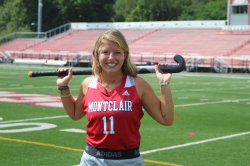
Independent study
Stewart was on track to become a speech pathologist, however a summer course in audiology, volunteering in the lab and her independent study changed her career trajectory. The way she sees it, her hearing loss has immersed her in the field of audiology.
“You could say I’ve been taking hearing classes for 21 years,” she says, smiling, “but it never really hit me as a profession until that class. And then I had an ENT appointment that summer, and I talked to my audiologist who has been doing my hearing tests since I was pretty young. My favorite part of going to the ENT was the hearing test because they’re not poking and prodding in your ear. I looked into it more and shadowed my audiologist, and then volunteering in the biofeedback lab, too. All of that is why I wanted to go into audiology.”
University faculty and staff helped Stewart achieve her goal of an independent study, a hurdle that required lots of research, work and persistence to gain registrar approval since she was an undergrad and not a graduate student. Adjunct Professor of Communication Sciences and Disorders Laura Ochs recommended the volunteer opportunity and Stewart worked closely with and assisted Michelle Turner, a speech-language pathology (SLP) doctoral student with whom she was paired, with research prior to her independent study.
Speech-language pathologist and Associate Professor of Communication Sciences and Disorders Elaine Hitchcock last year received a National Institutes of Health grant to research the telepractice delivery of speech and currently leads the research and clinical opportunities in the Clinical Biofeedback Lab. Hitchcock, who supervises Stewart’s research study, says that Stewart showed enthusiasm and commitment from the beginning and has demonstrated maturity and independence unexpected in someone so young. Stewart, who has worked as a restaurant hostess and a kayak/paddleboard tour guide in Ocean City for the past three summers trekked to the MSU-CBL for her volunteer service.
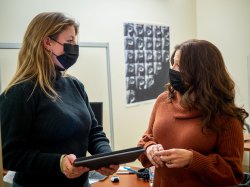
“How many students, not graduate students, undergraduate students would drive two and a half hours to be a volunteer?” Hitchcock says of Stewart’s weekly trips to the biofeedback lab over the summer. “What we identified pretty quickly was that Stewart was a highly skilled student. For an independent study, you have to want to work with them as the professor. They have to be somebody that you feel like you can trust, that you’re not chasing down and that will do quality work. That’s the kind of student you really want to support. Evyn is still an undergraduate – and a varsity athlete – and is doing an amazing job.”
In her graduate-level study, Stewart is researching the very thing with which she was diagnosed: unilateral hearing loss in adolescents; she’s comparing how their speech perception compares to their “typical hearing peers.” Under Hitchcock’s guidance, she is working with research participants on various tasks in order to record how they say, produce and repeat sounds or words, which will be contrasted with people who have no hearing impairments.
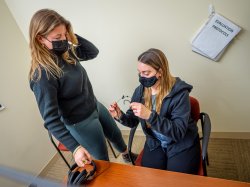
Recently, she was working with another Montclair student, Ashley Martino, officially known as “Participant 05” in the study. Martino, 22, has some hearing loss in her left ear due to a cholesteatoma, a cyst or skin growth behind the eardrum. A graduate student in Speech-Language Pathology, Martino was recruited as a research participant by another professor who was aware of her hearing loss. She says she has a hearing aid she does not wear. “My whole life, I’ve learned to adapt,” she says.
Stewart handed her headphones and ran her through a series of tests. In one test, Stewart has her repeat a list of “crazy made-up words,” beginning with single syllables, followed by double and triple and finally quadrisyllabic words, which Stewart records. The goal, she says, is to compare Martino’s and other research subjects’ perception of the words they hear with their pronunciation of them and see how they may differ.
While she’s still gathering and analyzing data, Stewart says that someone with unilateral hearing loss may have difficulty deciphering between ‘b’ and ‘p’ sounds, something with which she also struggles. “So, when I ask them to say ‘bo-ta-go’ or whatever the made-up word is, they might say ‘po-ta-go’ because they didn’t hear the ‘b’ sound from the initial output,” she says.
The research is important because while there has been research on bilateral hearing loss among students, there has not been much on the impact of unilateral hearing loss in young adults, says Hitchcock. “Let’s see if there’s anything uniquely different in our findings that may inform the research in one direction or the other,” she says, adding that it’s still preliminary.
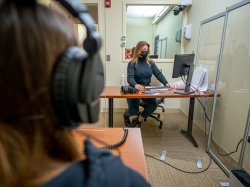
Grad school bound
Stewart has applied to a dozen audiology schools across the country and has been accepted to most, including Montclair. She has until April 15 to decide which she’ll attend. When she does, she will have three graduate level credits under her belt, says Hitchcock, who is happy for her even though she chose audiology over SLP.
“It’s not about me,” Hitchcock says. “My job is to give them opportunities. It’s her life, she should do what she wants. She was still here with me for a whole semester and then some, learning, growing and finding her path in life – it’s amazing.”
One of the first people with whom Stewart shared her decision to pursue audiology? Her audiologist of many years.
“She was really excited,” Stewart says smiling.
For more information on Audiology or Speech-Language Pathology, visit Communication Sciences and Disorders.
Story by Staff Writer Sylvia A. Martinez, Photos by University Photographer Mike Peters.
